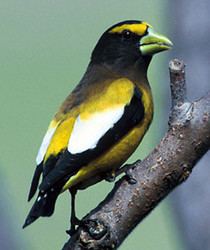Passerida is, under the Sibley-Ahlquist taxonomy, one of two "parvorders" contained within the suborder Passeri (standard taxonomic practice would place them at the rank of infraorder). While more recent research suggests that its sister parvorder, Corvida, is not a monophyletic grouping, the Passerida as a distinct clade are widely accepted.
Systematics and phylogeny
The Passerida quite certainly consist of the 3 major subclades outlined by Sibley & Ahlquist (1990). However, their content has been much revised. In addition, it has turned out that not all passeridan lineages neatly fit into this arrangement. The kinglets are so distinct that they might actually form a separate infraorder, as they are only slightly less basal than the Corvoidea or the Picathartidae. See Jønsson & Fjeldså (2006) for details on phylogeny.
Mostly insectivores, distribution centered on the Indo-Pacific region. Few occur in the Americas.
Alaudidae: larksHirundinidae: swallows and martinsPhylloscopidae: leaf-warblers and allies. Recently split from Sylviidae.Aegithalidae: long-tailed titsCettiidae: ground-warblers and allies. Recently split from Sylviidae.Megaluridae: grass-warblers and allies. Recently split from Sylviidae.Bernieridae: Malagasy warblers. A newly assembled family.Acrocephalidae: marsh- and tree-warblers. Recently split from Sylviidae.Pycnonotidae: bulbulsCisticolidae: cisticolas and alliesSylviidae: "true/sylviid warblers" and parrotbills. Might be merged into Timaliidae. Monophyly needs confirmation.Zosteropidae: white-eyes. Probably belongs into Timaliidae.Timaliidae: babblers. Monophyly needs confirmation.Sylvioidea incertae sedis"African warblers": A proposed clade, but monophyly needs confirmation. Formerly in Sylviidae.Donacobius: black-capped donacobius. Monotypic family? Tentatively placed here; possibly closest to Megaluridae. Formerly in Troglodytidae.Nicator: Relationships unresolved, monotypic family? Tentatively placed here; formerly in Pycnonotidae.Panurus: bearded reedling (bearded "tit"). Relationships enigmatic, monotypic family Panuridae? Tentatively placed here; formerly in "Paradoxornithidae".Mostly insectivores, near-global distribution centered on Old World tropics. One family is endemic to the Americas.
Cinclidae: dippersMuscicapidae: Old World flycatchers and chats. Monophyly needs confirmation.Turdidae: thrushes and allies. Monophyly needs confirmation.Buphagidae: oxpeckers. Formerly usually included in Sturnidae.Sturnidae: starlings and possibly Philippine creepers. Placement of latter in Muscicapoidea seems good, but inclusion in Sturnidae requires confirmation; possibly distinct family Rhabdornithidae.Mimidae: mockingbirds and thrashersMostly herbivores, near-global distribution centered on Palearctic and Americas. Includes the nine-primaried oscines (probably a subclade).
Passeridae: true sparrowsPrunellidae: accentorsMotacillidae: wagtails and pipitsUrocynchramidae: Przewalski's finch. Recently split from Fringillidae; tentatively placed here.Estrildidae: estrildid finches (waxbills, munias, etc.)Ploceidae: weavers. Certain members of Ploceidae, such as the long-tailed widowbird are well known for their elaborate sexual ornaments.Viduidae: indigobirds and whydahsNine-primaried oscinesPeucedramidae: olive warblerFringillidae: true finches. Includes the Hawaiian honeycreepersIcteridae: grackles, New World blackbirds, and New World oriolesParulidae: New World warblersThraupidae: tanagers and alliesCardinalidae: cardinalsEmberizidae: buntings and American sparrowsCalcariidae: snow buntings and longspursPasseroidea incertae sedisCoerebidae: bananaquit. Family invalid or not monotypic; reallocation pending.Rather basal Passerida, most of which seem to constitute several small but distinct superfamilies. Most occur in Asia, Africa and North America.
Possible superfamily "Dicaeoidea" – sunbirds and flowerpeckersNectariniidae: sunbirdsDicaeidae: flowerpeckersPossible superfamily Bombycilloidea – waxwings and alliesBombycillidae: waxwingsDulidae: palmchat. Tentatively placed here.Ptiliogonatidae: silky flycatchers. Tentatively placed here.Hypocoliidae: hypocolius. Tentatively placed here.Possible superfamily Paroidea – titmice and alliesParidae: tits, chickadees and titmiceRemizidae: penduline tits. Sometimes included in Paridae.Stenostiridae: stenostirids ("flycatcher-tits"). A newly assembled family; sometimes included in Paridae.Possible superfamily Sittoidea or Certhioidea – wrens and allies.Sittidae: nuthatchesTichodromadidae: wallcreeper. Tentatively placed here.Certhiidae: treecreepersSalpornithidae: spotted creeper. Tentatively placed here; might belong into Certhidae.Troglodytidae: wrensPolioptilidae: gnatcatchersPossible monotypic superfamily N.N.Promeropidae: sugarbirdsPossible monotypic superfamily N.N.Family N.N.: hyliotas. Recently split from Sylviidae.Possible superfamily Reguloidea – kinglets. Tentatively placed here.Regulidae: kingletsThese have been assigned to the Passerida in recent times, often based on DNA-DNA hybridization data. However, they are probably more basal among the songbirds and would belong either to the Corvoidea or the allied basal lineages. Most of them are either African or Wallacean groups.
Chloropseidae: leafbirdsAegithinidae: iorasPicathartidae: rockfowlMelanocharitidae: berrypeckers and longbillsParamythiidae: tit berrypecker and crested berrypeckersPlatysteiridae: wattle-eyes or puffback flycatchers
